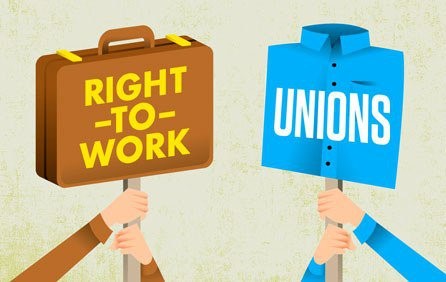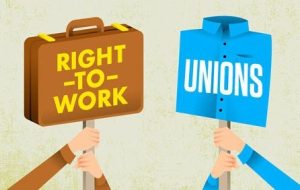Resolved: In the United States, right-to-work laws do more harm than good.
Definitions
As Makridis 19 explains, Right to work laws prohibit union security agreements between companies and unions, which means that employees in unionized workplaces are not required to pay for union representation.
Contention 1 – Eisenach 2018 argues RTW laws create more business opportunities
- Private sector employment grew by 27 percent in RTW states between 2001 and 2016, compared to 15 percent in non-RTW states.
- On average, the annual unemployment rate in RTW states was 0.4 percentage points lower than in non-RTW states. In concrete terms, if non-RTW states had had the same unemployment rate as RTW states in 2017, approximately 249,000 more people would have been employed.
- Output has also grown faster in RTW than in non-RTW states, rising by 38 percent between 2001 and 2016, compared to 29 percent in non-RTW states. Four of the top five states with the largest growth in real per capita output over this period are RTW states.
- The gap in manufacturing output is also substantial: Real manufacturing output rose by over 30 percent in RTW states between 2001 and 2016 compared with 21 percent in non-RTW states.
- Higher growth rates translated into higher personal incomes: Personal income in RTW states rose over ten percentage points more than in non-RTW states between 2001 and 2016, 39 percent versus 26 percent.
- Businesses tend to locate in RTW states, as evidenced by the more rapid growth of firms and establishments.
- As of 2017, about four percent of private sector workers in RTW states belonged to unions, compared with about nine percent in non-RTW states.
Although these observations do not in and of themselves demonstrate a causal relationship between state performance and RTW status, they are consistent with and support the findings in the existing empirical literature, which suggest that RTW laws are beneficial to a state’s overall economic performance.
Contention 2 – Unions Bad
- Slows productivity
- Cook 21, Districts facing union pressure increase teacher salaries and benefits, spend down reserves, and experience no student achievement gains. Conversely, districts facing less pressure hire more teachers and realize significant student achievement gains.
- Discourage innovation
- Bradely 13, Passing a union election leads to an 8.7% (12.5%) decline in patent quantity (quality) three years after the election. A reduction in R&D expenditures, reduced productivity of current and newly hired inventors, and departures of innovative inventors appear plausible mechanisms through which unionization impedes firm innovation.
- Risk market disruption
- CNBC 22, A labor dispute in the railway system can cost up to 2 billion USD a day
- LA Times report, Disruptions of up to 20 million packages when UPS goes on strike
- Introduce rigidity in the labor market
- Mathur 17, in many ways unions made matters worse for companies facing those changing global forces. Typically, union wage premiums arise because unions negotiate compensation packages that are artificially above market compensation levels. For firms facing global competition, unions raise their employers’ labor costs and make them less competitive. This hastened the outsourcing of production overseas to take advantage of lower manufacturing labor costs in other countries.
Contention 3: Unions less relevant
The decline in unions also reflects the shift toward service-sector work. According to BLS projections, the 30 fastest growing occupations between 2014 and 2024 will be in the service economy. A one-size-fits-all union-type compensation contract with pay determined mostly by seniority and not merit is no longer desirable or relevant for the workers of the 21st century. America’s workers are no longer are best served by union representation that ignores individual effort and merit-based compensation.
For workers to rise up to the challenge of performing today’s jobs and to enjoy wage gains, investing in skills training and education is a far better path forward than paying union dues to be represented by outdated organizations that will become increasingly irrelevant in the workplaces of the future.
Unions have declined largely because they have become less relevant in a global economy. Middle class workers are more likely to be employed by small service firms. This type of labour market offers a higher premium on human rather than firm-specific capital. This leaves little scope for unions. Workers become less reliant on an individual employer and not as dependent on a union to advocate for them. Paying a hefty chunk of your pay cheque for union dues becomes less attractive.
Citations
Jason Cook, Rent-Seeking through collective bargaining: Teachers unions and education production, 2021 (https://www.sciencedirect.com/science/article/abs/pii/S0272775721001084)
Jeffrey A. Eisenach, Ph.D., Right-to-Work Laws: The Economic Evidence, NERA Economics Consulting, May 2018 (https://www.nera.com/content/dam/nera/publications/2018/PUB_Right_to_Work_Laws_0518_web.pdf)
Daniel Bradley, Incheol Kim, and Xuan Tian The causal effect of labor unions on innovation 2013 (https://papers.ssrn.com/sol3/papers.cfm?abstract_id=2232351)
CNBC 22 – https://www.cnbc.com/2022/09/08/deadline-for-rail-strike-which-could-cost-2-billion-a-day-nears.html
LA Times – https://www.latimes.com/business/story/2023-01-30/ups-strike-risk-union-fight-teamsters






